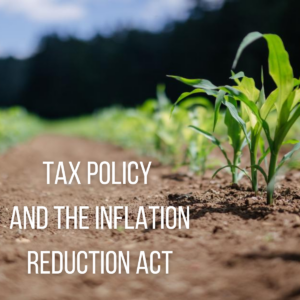Solar Tax Credit
How the 2024 Election Could Reshape U.S. Tax Policy and the Future of the IRA Published October 9, 2024 – As the 2024 election approaches, a new president and Congress are set to take office in January, which means legislative action could reinvent the U.S. tax landscape. The presidential election races are underway; however, for the House and Senate, the race is increasingly important as it determines the direction of tax legislation. What is the Inflation Reduction Act and How will the Election Affect This Law? In 2022, President Biden signed the Inflation Reduction Act (IRA) into law. One year after the IRA was passed, the clean energy and climate provisions created more than 170,000 renewable energy jobs, companies announced over $110 billion in renewable energy manufacturing investments, and we are hitting our goals to reduce greenhouse gas emissions by 1 billion tons in 2030. This is beneficial for developers as it encourages them to focus on sustainability and clean energy projects in a cost-effective way. Now, for tax equity investors, this industry growth and the bonus’ from the IRA is a great increase in tax equity investment opportunities for them across the country. How will the new election affect the IRA? The United States will go to the polls in November to decide who will become the next president, and this election year can significantly impact the IRA in a few ways: Funding and Implementation: Depending on the election’s outcomes, the next president’s administration may seek to modify, expand or even scale back certain aspects of the IRA. Decisions can be made to fully implement and expand the IRA or repeal and alter provisions. Implementation and Expansion of the IRA: Depending on the winning party, this can lead to two different outcomes: The first outcome can be full implementation, which…
Read MoreTransferable Tax Credit Due Diligence Checklist Summary Published May 28, 2024 – The Inflation Reduction Act (IRA) has brought significant changes to the landscape of renewable energy, including the introduction of transferable tax credits. Transferable tax credits have become a popular financial tool that allows businesses to reduce tax liabilities by investing in the growing market of renewable energy. As the transferable market continues to grow, it is imperative to stay informed and execute careful planning and due diligence. To prepare for a transferable tax credit transaction, a due diligence checklist needs to be put into place. Establishing a checklist not only provides a list of standard deliverables, but it allows stakeholders to focus on strategy, structure and deal execution. Foss & Company’s Partner & Managing Director, Bryen Alperin, was able to collaborate with Norton Rose Fulbright’s Partner, David Burton, Aon’s Global Co-Ceo of M&A and Transaction Solutions, Gary Blitz, and Winthrop & Weinstine Associate, Amber Peterson to publish a due diligence checklist sample stemming around the transfer of tax credits. This expert team developed a due diligence checklist that will show how the scope can vary depending on the complexity and type of credit transfer. To explore the potential of transferable tax credits, investors and developers need a trusted and innovative partner. Partnering with Foss & Company will offer innovative solutions that empower developers and investors to maximize the value of tax credits while driving positive impact in communities across the nation. Reach out to our team today to learn how our commitment ensures your projects not only succeed financially but leave a lasting legacy. To dive into the transferable tax credit due diligence checklist, download our white paper today!
Read MoreThe Texas Hailstorm: A Catalyst for Change in the Solar Industry By: Bryen Alperin, Partner and Managing Director of Renewable Energy & Sustainable Technologies, Foss & Company In the wake of the recent Texas hailstorm, which inflicted considerable damage on a 350-MW solar farm, stakeholders across the renewable energy spectrum are reevaluating the implications of hail risk for future projects. Foss & Company is still excited to invest in regions such as Texas, and believes these transactions can be low risk if structured appropriately. This event has not only highlighted the need for investors to structure around extreme weather risks, but has also sparked a broader conversation about resilience, insurance, and innovation within the renewables industry. This blog will outline some of our initial takeaways and recommendations. Strategic Recommendations for Investors The recent hailstorm event in Texas serves as a critical lesson for investors in the renewable energy sector, particularly those involved with solar projects. To mitigate risks and safeguard investments against similar incidents in the future, we offer the following specific recommendations: Mandate Hail Stow Protocols: Investors should consider requiring solar projects in their portfolios to operationalize hail stow protocols. These protocols are essential measures designed to protect solar panels during severe weather events, thereby minimizing potential damage and associated losses. Ensuring that these practices are not only in place but also rigorously adhered to, is a crucial step in enhancing the resilience of solar investments. Closely Manage Insurance Coverage: A comprehensive risk management strategy should include a well-structured insurance portfolio that combines natural catastrophe insurance and tax insurance. Investors should do ongoing compliance monitoring to ensure that insurance policies are renewed, and coverage does not lapse. Furthermore, investors should understand exceptions to their coverage, and ideally have a strong sponsor guaranty that covers any gaps. Incorporate Rebuild Covenants: Tax investors should…
Read MoreFoss & Company is comprised of a group of experienced tax credit professionals, representing a depth of knowledge within their respective fields. In this blog series, we highlight different Foss & Company team members to shine a light on the diverse and dedicated people that help make us who we are. As the Vice President of Renewable Energy Portfolio Management, Andrew is in charge of all aspects of investment performance, working with sponsors on project compliance and tax credit investors on fund management. Prior to joining Foss & Company, he created a solar investment vehicle and managed its day-to-day operations. For 12 years prior to that he worked with top-tier solar or renewable energy companies, either financing assets or developing premier asset and portfolio management talent and processes globally. He has overseen some of the largest solar and wind farms in North America, as well as solar sites in Chile, Italy, Spain, England, and Canada. His education credentials include an MBA from ESADE in Barcelona, and a BA from UC Santa Barbara. To learn more about Andrew, read our latest Spotlight blog series installment: How did you get started in the tax credit investing industry? In 2006, while working on Wall Street doing CleanTech sell side equity research, I came across an opportunity to develop a financing platform for a residential solar company in San Luis Obispo (SLO), CA. I packed up my Prius and drove from Manhattan to SLO, excited for the new opportunity to help a growing company focused on solar. We had some success developing and implementing home equity loans for solar and the team sold the first SunRun PPA deal, which was effectively a tax equity investment. From there I joined a structured finance desk with a solar developer raising tax equity in 2008. I haven’t…
Read MoreBy: Dawn Lima, Vice President of Renewable Energy & Sustainable Technology, Foss & Company I recently attended the Carbon Capture, Utilization and Sequestration (CCUS) Summit in League City, TX, and the Carbon Capture Coalition’s Annual Meeting in Denver, CO. These events were very successful as well as insightful and I left feeling energized and motivated. It’s always enjoyable to be surrounded by like-minded professionals while making many new connections. I wanted to share some key takeaways from both events. Capture the CO2: CCUS Summit I was very impressed with the active participation from stakeholders across the CCUS industry. There is incredible excitement around CCUS right now, fueled in part by the passing of the Inflation Reduction Act (IRA) in 2022, but mainly due to a motivation to decarbonize our energy sector and achieve climate goals. During the CCUS Summit, we had participants join all the way from Canada, Asia, Europe and South America. The US’ carrot versus stick approach to incentivizing investments through tax credits has certainly captured the attention of other nations and companies. This is evident as we have seen an increase in investment in US-based projects to capitalize on the US tax credit incentives. What was clear during this event is that innovation and collaboration is critical to reaching our climate and net-zero goals. What Are My Thoughts? As we sat down with industry leaders, during our discussions there were some interesting questions that had come up, include: Is the CCUS industry innovating equally in both important areas? Does the 45Q tax credit incentivize both sequestration and utilization equally? Are we – as a CCUS industry – working on CCU projects as well as CCS projects? The short answer? No. In its current form, the 45Q tax credit does not incentivize CCU equally compared to enhanced oil…
Read MoreBy: Bryen Alperin, Partner and Managing Director of Renewable Energy & Sustainable Technologies, Foss & Company The U.S. Treasury Department and IRS have recently announced the release of proposed regulations (REG-132569-23) for publication in the Federal Register. These regulations are set to amend the existing rules under section 48, incorporating modifications from the Inflation Reduction Act of 2022 (IRA), previous legislative changes, and various administrative guidelines. The Notice of Proposed Rulemaking (NPRM) extends over 127 pages and aims to provide both clarifications and updates concerning the energy tax credit. Initial Foss Takeaways: Key Points for Investors Uncertainty for Biogas Equipment: In a surprising outcome, the proposed rules indicate that “gas upgrading equipment necessary to concentrate the gas into the appropriate mixture for injection into a pipeline through removal of other gases such as carbon dioxide, nitrogen, or oxygen is not included in qualified biogas property”. However, it emphasizes the eligibility of costs associated with essential components of biogas projects, such as equipment for cleaning and conditioning the gas. This has caused confusion and uncertainty in the RNG industry, as many projects feature equipment that both cleans and concentrates the gas. The implication of the proposed rules is that investors will need to do a detailed review of the process flow diagrams and determine which costs are associated with equipment which cleans or conditions gas versus equipment that concentrates gas. Depending on the determination, large portions of existing RNG projects may not qualify for the ITCs they thought they would. The industry will be lobbying to have this definition changed, or further clarified. New “Placed in Service” Criteria: The NPRM proposes a new definition of “placed in service” for Section 48, replacing long-relied-on Section 46 regulations. The definition is as expected and states that projects generating tax credits are considered…
Read MoreDid you know the key to a sustainable future lies within Renewable Energy Credits (RECs), corporate savings and tax equity investments? The dynamic synergy between these three showcase how corporations can strategically leverage tax equity to not only address their tax liabilities but also advance their commitment to sustainability. What are Renewable Energy Credits? With the federal government taking strong action on climate change, corporations are analyzing their carbon footprint and realizing that investing in Renewable Energy Credit (RECs) agreements and tax equity transactions can lead to being more environmentally responsible while helping improve their bottom line. Now, not all renewable energy sources come strictly from energy systems like solar panels or wind turbines. RECs are created as long as one megawatt-hour (MWh) of electricity is generated from a renewable energy source and delivered to an electric grid. Once it’s generated, corporate customers are able to purchase RECs, therefore allowing the use of renewable energy without installing renewable energy systems. How do Tax Equity Investments Tie In? Tax equity investments help fund viable renewable energy projects by enticing investors with a combination of tax savings and cash returns. As for developers, it provides a way to get new projects off the ground. Tax credits are government subsidies for projects like renewable energy, but many developers lack the tax liability to fully use them. That’s where tax credit investments come in. Companies with large tax liabilities can invest and receive tax credits, depreciation benefits and cash flows. RECs bolster the renewable energy market and are a cost-effective, environmentally friendly and decentralized method of carbon reduction. What Role Do RECs Play in the Tax Equity Market? RECs and REC markets play a key role in driving new renewable energy deployment and projects by guaranteeing an income stream for new…
Read MoreRepost of the original article in the Novogradac Journal of Tax Credits, which can be found here. As the renewable energy market continues to grow, the popularity of transferable tax credits as a way to fund projects and reduce corporate tax liabilities is on the rise. Following the passage of the Inflation Reduction Act, provisions enabling the transfer of tax credits have become hot topics for both developers and investors. In this article, we’ll discuss several common misconceptions regarding transferable tax credit transactions. Transferable Tax Credits Overview Transferable tax credits are a valuable financial instrument that allows businesses to reduce their tax liabilities by investing in projects that generate economic, social or environmental benefits. These tax credits can be sold or transferred between taxpayers, enabling companies with little or no tax liability to monetize the credits and create a new revenue stream. As attractive as this financial tool may seem, it’s essential to understand the associated risks. Myth #1: Transferable Tax Credit Buyers Have No Risk When speaking to project developers or prospective investors, we often hear transferable tax credits compared to state certificated tax credits which have almost no risk associated with them. Unfortunately, there are some risks associated with transferable tax credit transactions and it is important for investors to understand those risks. The risks associated vary across the different types of tax credits eligible for transferability. For example, clean energy investment tax credits (ITCs) are subject to recapture risk for five years following the project being placed in service. Carbon sequestration tax credits are subject to a three-year recapture period and the triggering events for recapture are quite different. Clean energy production tax credits (PTCs) are not subject to recapture, but do face volume risks which could lead to under delivery of tax credits in some years.…
Read MoreAs the world increasingly recognizes the urgent need to transition to clean and renewable energy sources, governments around the globe are implementing various incentives to boost investment in the renewable energy sector. In the United States, two prominent incentives are the Production Tax Credit (PTC) and the Investment Tax Credit (ITC). Under the Inflation Reduction Act (IRA), these tax credits have been enhanced to further encourage the development and utilization of renewable energy projects. By gaining an understanding of how the IRA has enhanced its influence on renewable energy investment, investors can make more informed decisions when it comes to allocating their resources. Production Tax Credit The PTC has long been a crucial policy tool in promoting renewable energy in the United States. It provides a tax credit to project owners based on the electricity production from qualified renewable energy facilities. Historically, the PTC has primarily supported wind energy projects, but through the IRA, its scope has expanded to include other renewable sources such as biomass, geothermal, hydropower, and marine energy. Investment Tax Credit The ITC is another critical component of the U.S. government’s renewable energy policy framework. Unlike the PTC, which focuses on electricity generation, the ITC provides tax credits based on the capital investment in qualifying renewable energy projects. It applies to a wide range of technologies, including solar, wind, geothermal, fuel cells, and combined heat and power systems. Comparing the PTC and ITC under the IRA Under the IRA, the PTC and ITC are invaluable tools for accelerating renewable energy investment in the United States. With enhanced eligibility periods, increased credit rates, and broader technology coverage, the PTC incentivizes renewable energy production, particularly in the wind sector. The extended ITC eligibility and inclusion of energy storage systems under the IRA fosters the integration of renewable energy sources…
Read MoreBattery energy storage systems (BESS) have received significant advancement in the United States due to the implementation of the Inflation Reduction Act (IRA), opening new opportunities for their development. This groundbreaking legislation introduces unprecedented economic benefits for standalone storage systems by making them eligible for a 30% investment tax credit (ITC), with the potential to increase to 70% through additional incentives. Historically, federal tax credits were only available for storage systems that were paired with renewable energy generation, such as solar power. However, the IRA has extended the eligibility of tax credits to standalone storage systems, which is anticipated to unleash a remarkable surge in storage investments. This landmark development holds immense potential, opening new avenues for investment and accelerating the transition towards a sustainable and reliable energy grid. Enhanced Investment Opportunities The IRA provides the investing environment with much needed certainty by extending the duration of ITCs. The increases and expansions of ITCs given through the IRA are now guaranteed through 2032 rather than being subject to temporary renewals. This more extensive timetable gives investors and developers the chance to strategically plan and maximize their returns. Additionally, the definition of project costs eligible for the tax credit has been expanded to include interconnection, microgrid controllers, and a broader range of components commonly used in clean energy systems. This can increase tax credit eligibility and accelerate project development. Leveraging Incentives Energy storage projects must adhere to labor standards in order to fully benefit from the tax incentives provided under the IRA. These criteria make sure that registered apprenticeship standards are followed and that prevailing salaries are paid. If a project satisfies these requirements, it may be further enhanced by three additional incentives: domestic content, energy communities, and low-medium income (LMI) initiatives. The domestic content incentive incentivizes the utilization of…
Read MoreBy Bryen Alperin, Managing Director This blog is the second in a series that will explore the opportunities in the transferability of renewable tax credits for investing in renewable energy and reducing tax liability. The Inflation Reduction Act, signed into law on August 16, 2022, has created new opportunities to invest in a sustainable future. There are many options, but one of the more promising is new transfer provisions which allow for the transfer of renewable energy tax credits between taxpayers. With these new transfer provisions, a taxpayer can purchase a tax credit generated from an eligible project, for example, at $0.90 per $1 of tax credit and then apply the credit to reduce required tax payments to the IRS by the full $1. We know enough about transferability to be certain that this added feature in the Internal Revenue Code will allow for a meaningful new avenue to access tax credits from renewable energy projects, and we expect these changes to expand the population of taxpayers that participate in the renewable tax credit market. The industry anxiously awaits guidance from the IRS on the intricacies of transferability, and when that guidance will be delivered is still uncertain. However, we do have solid visibility into what participants can expect, including that: Taxpayers can elect to transfer all or a portion of their tax credits to a non-related transferee. Payment for credits must be in cash. The tax credit amount will not be included in taxable income, nor deductible. There are no caps or phase outs (unlike direct pay). Election must be made no later than the due date (including extensions) for the respective tax return, and is irrevocable. Transferees cannot re-transfer the credits. If the tax credit is generated by a partnership, the partnership needs to make the election. Transferability…
Read MoreFoss & Company 2022 project, Radical Hotel Many companies have long overlooked tax equity investing as part of their tax strategy for different reasons. But this past year has presented new, unique opportunities in the tax equity market for both developers and investors. The Inflation Reduction Act (IRA) has provided more incentives than ever in US history for tax credit investments and facing the current challenge of inflation and increasing interest rates, tax equity may be essential to push projects forward. 2022 proved to be a big year for Foss & Company as well. In June, Foss announced that in addition to the over $8 billion in tax equity the company has deployed since its inception, we have over $1 billion in tax credits currently under management. Among other milestones, the Foss & Company team has continued to grow. We welcomed 14 new team members who have helped grow our capital markets, renewable energy, marketing and real estate teams. We are also pleased to share that in August of 2022, Foss & Company featured North Carolina project, Capitola Mill, won the Gertrude S. Carraway Award for demonstrating a commitment to extraordinary leadership, research, philanthropy, promotion, and/ or significance in preservation. We could not be more thrilled with our successes in 2022, and we could not have done it without our dedicated team, developer partners and investor clients. Vision 2045: A Look Towards the Future In 2022, Foss & Company had the unique opportunity to be featured in the Vision 2045 campaign. This campaign supported the United Nations and its objectives for the institution’s 100- year anniversary in 2045 and aimed to inspire businesses and people to take collective action to ensure a better future for all. As part of this multi-faceted campaign, Foss & Company produced a short, documentary-style video that highlighted…
Read MoreGrowth continues in 2018 January 24, 2018, San Francisco CA – Foss and Company is pleased to announce that they closed out the 2017 calendar year having managed over $20 million in solar tax credit investments. The investments were made into seven unique projects that were all Massachusetts-based and approached 20 megawatts in scale. Foss Renewables Managing Director Alex Tiller said, “We were pleased with our 2017 results and are looking forward to investing over 10 times that amount in 2018 via our new renewable energy focused fund.” Tiller went on to say, “renewable energy investments are nothing new to this firm. Over our last 35 years we’ve managed over $500 million in renewable and alternative energy tax credit investments including some of the first large scale solar thermal SEGs projects in the Mojave Desert way back in the 1980’s. We’ve participated in landfill gas, refined coal and anaerobic digesters transactions as well. Foss and Company is a nationally recognized institutional investment management firm dedicated to providing corporate investors the greatest access to federal and state tax credit driven investments in the tax credit marketplace. Their services for solar developers include market pricing and transaction structuring, direct tax credit equity investments and private placement services. Additional information about the company is available at: fossandco.com
Read More











